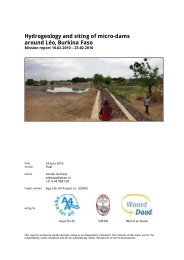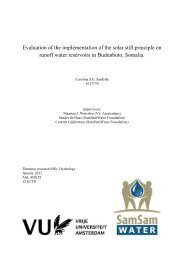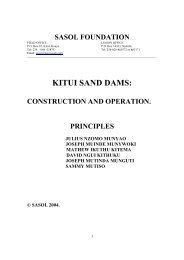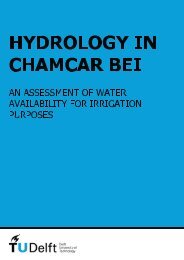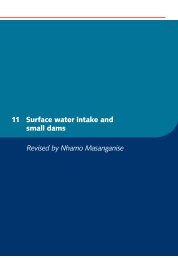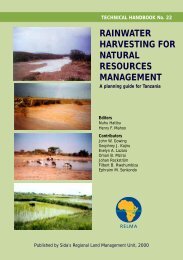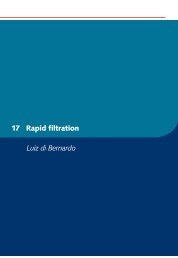Water from Small Dams
Water from Small Dams - SamSamWater
Water from Small Dams - SamSamWater
Create successful ePaper yourself
Turn your PDF publications into a flip-book with our unique Google optimized e-Paper software.
4.4 ConstructionThe construction site should be cleared of all vegetation, including the semi-circulararea where the excavated soil will be placed as the dam wall on the lowest side of thewater reservoir.Then the outlines of the dam reservoir and the half-circular dam wall are drawn andpegged out using a long string tied to the centre of the dam reservoir. A two metrewide space, called a berm, should be left untouched between the dam reservoir andthe dam wall. Its purpose is to facilitate transportation of soil, while also preventingsoil <strong>from</strong> the dam wall to slide back into the excavated reservoir. The excavated soilshould form a semi-circular dam wall (embankment) all around the water reservoir,except at the inflow channel, to reduce wind speed and evaporation. The slopes of thedam wall should be flatter than 1:1 (45 degrees). The top of the dam wall, called thecrest, must be highest opposite the inflow channel to prevent wash-out of the damwall.Rainwater must not be allowed to wash any soil back into the pond. Therefore, treesand grass should be planted on the dam wall to protect it <strong>from</strong> erosion and create awindbreak. More trees should be planted outside the embankment on the side towardsthe prevailing wind to form a windbreak, which will reduce evaporation losses andprovide firewood, poles and timber.Another way to reduce evaporation and conserve water towards the end of the dryseason is to deepen one end of the dam reservoir. As the pond dries out, the remainingwater will accumulate in the deeper section and minimise the area of water exposed toevaporation.A spillway should be built at each end of the curved dam wall that reaches the inflowchannel. These two spillways will facilitate excess water to spill over the waterreservoir safely. Large stones should be placed along the lower side of the twospillways to prevent erosion of the dam wall.A series of silt traps also need to be constructed to reduce the volume of sedimententering the dam reservoir. These can be made by excavating depressions in the flatland before the inflow channel. Sediment trapped in the silt traps should be removedafter rain showers, so the silt traps do not get filled up with silt. The removed silt isrich in nutrient and therefore an excellent fertiliser for a vegetable garden.4.5 ConstraintsThere are a few constraints to the increased adoption of charco dams, such as:1) Lack of technical knowledge for design, construction and maintenance - untilthis handbook is published.2) The volume of the water reservoirs is reduced if silt is not removed <strong>from</strong> thesilt traps after rain showers.3) Seepage losses where dams in sandy soils have not been lined.4) Evaporation losses where dams have insufficient wind breaks.21



